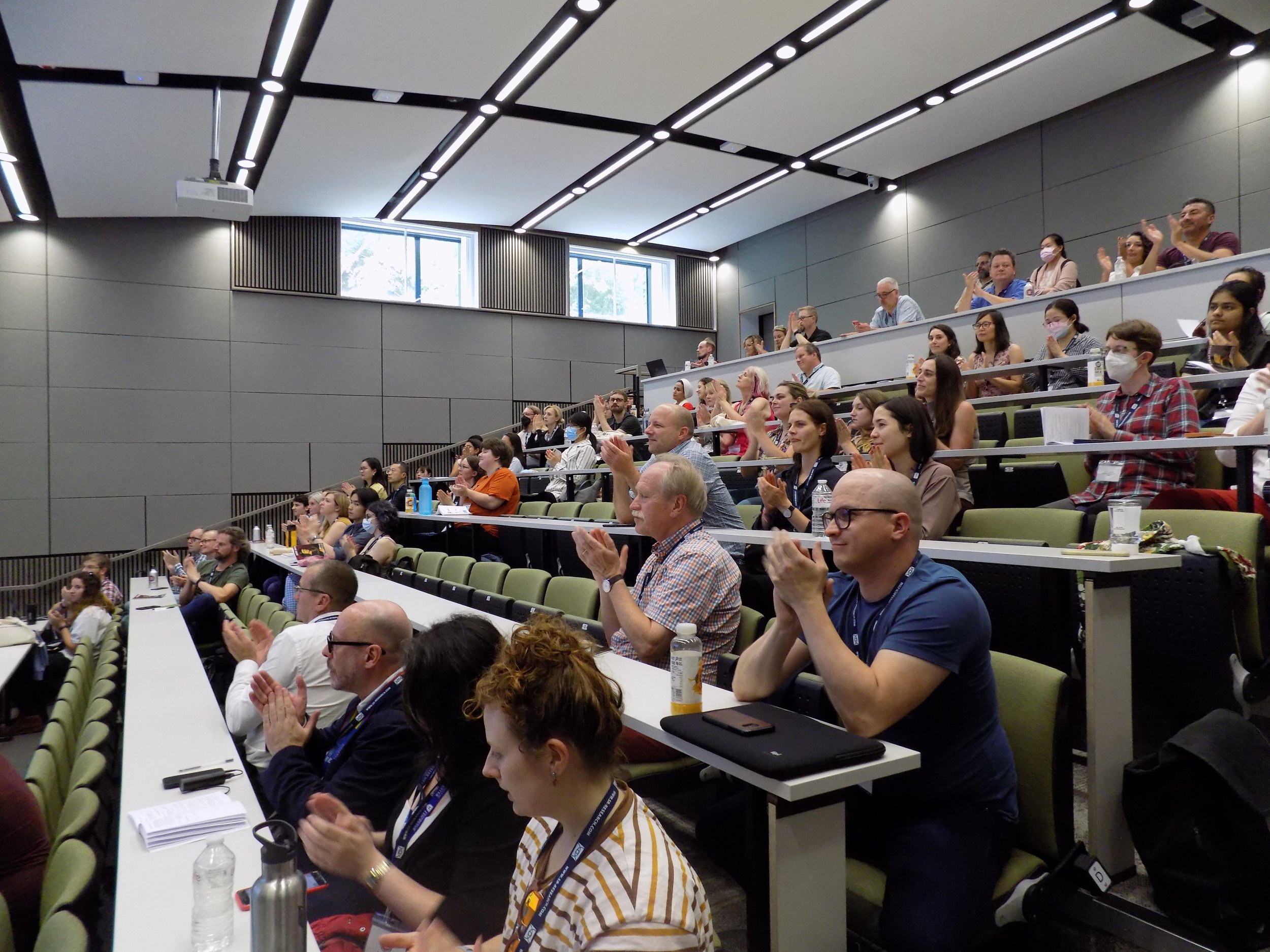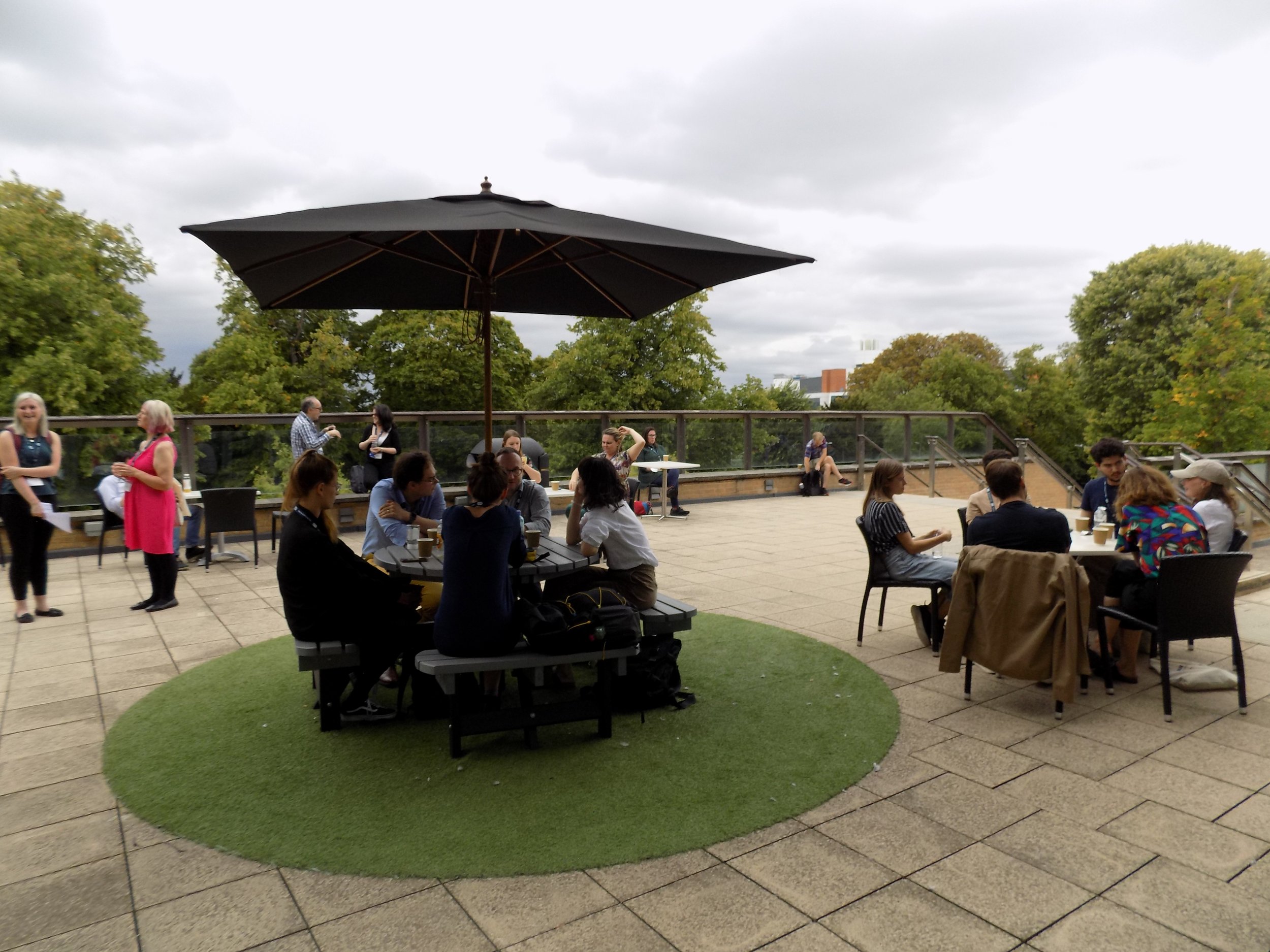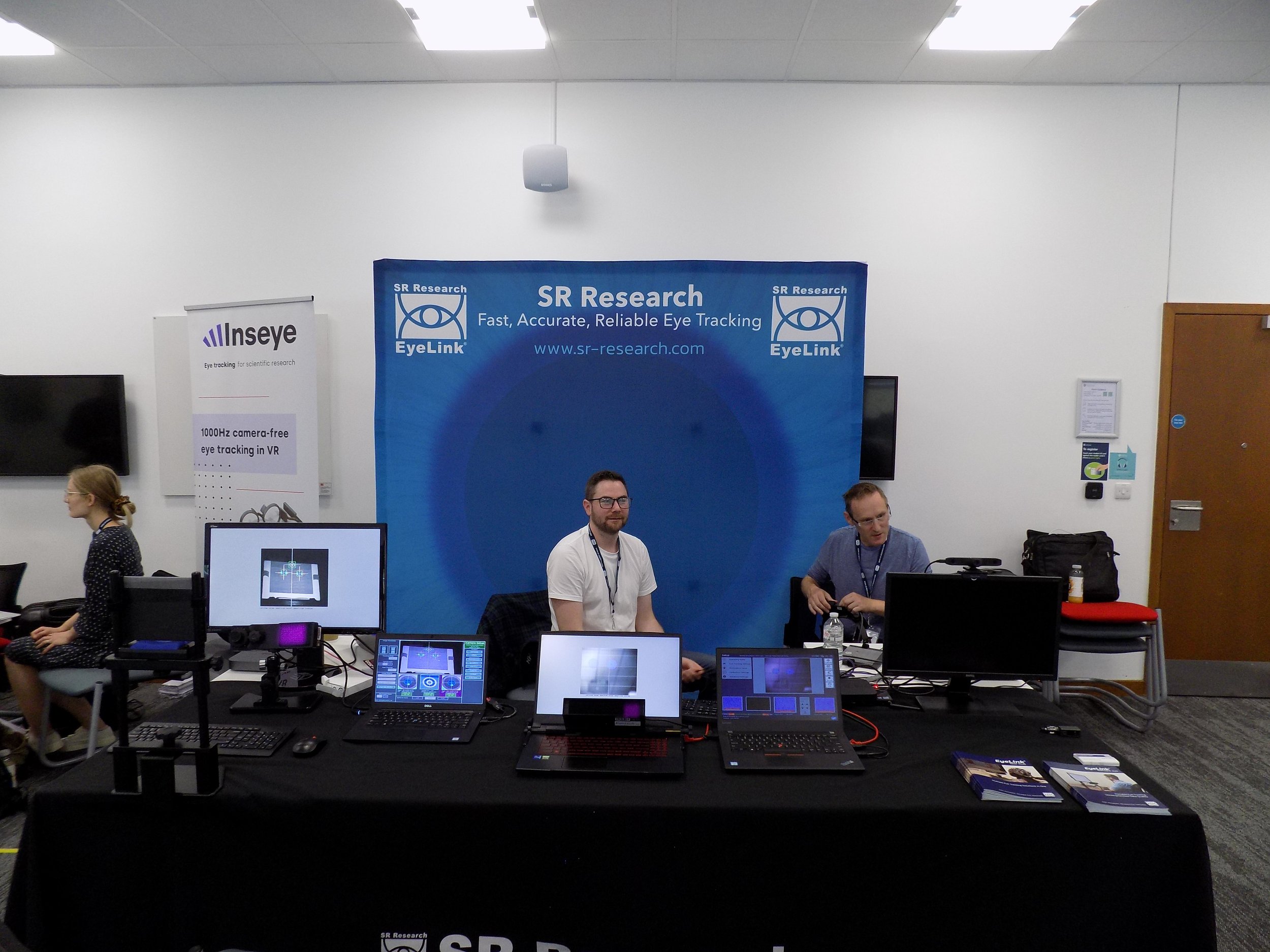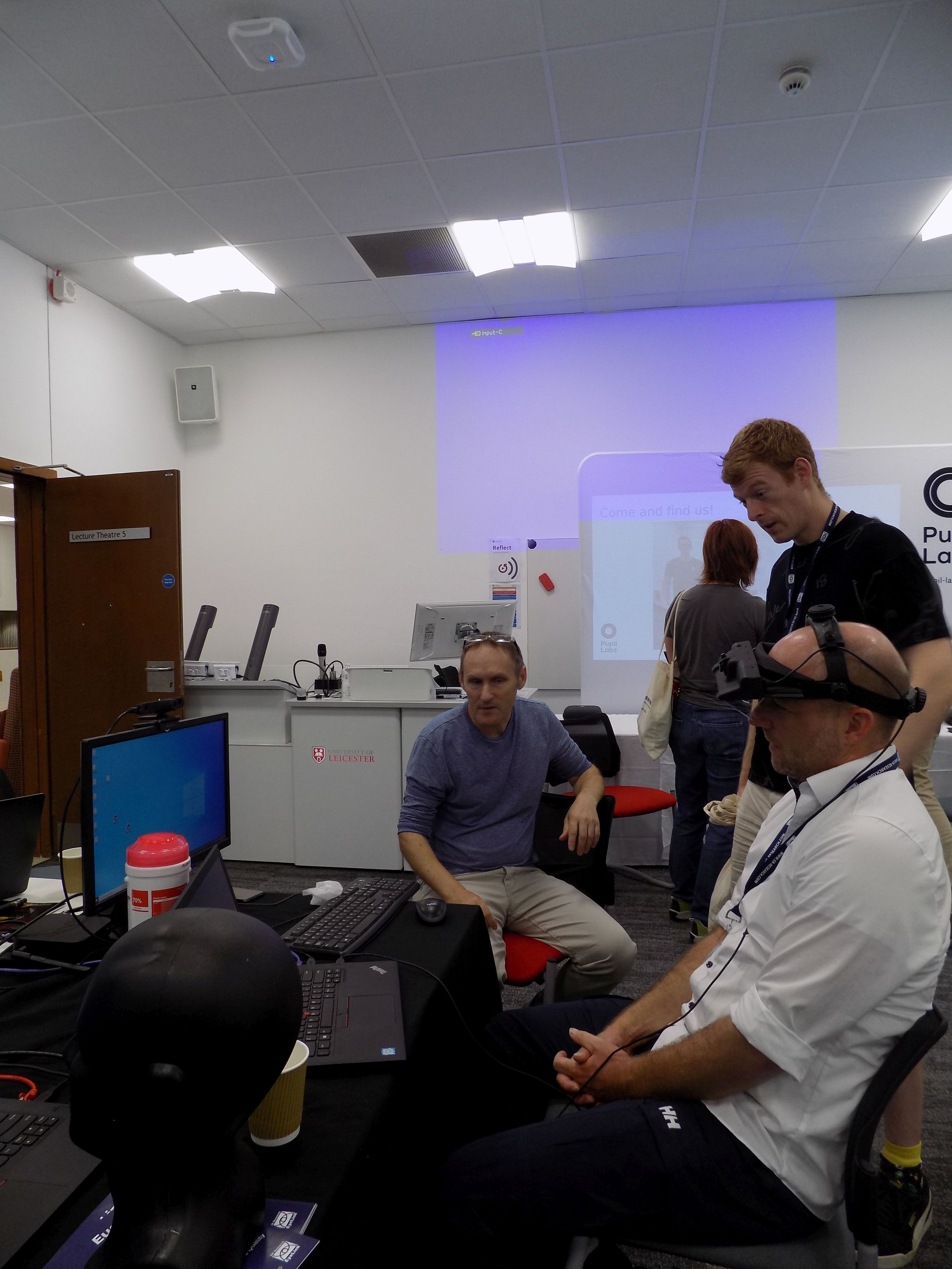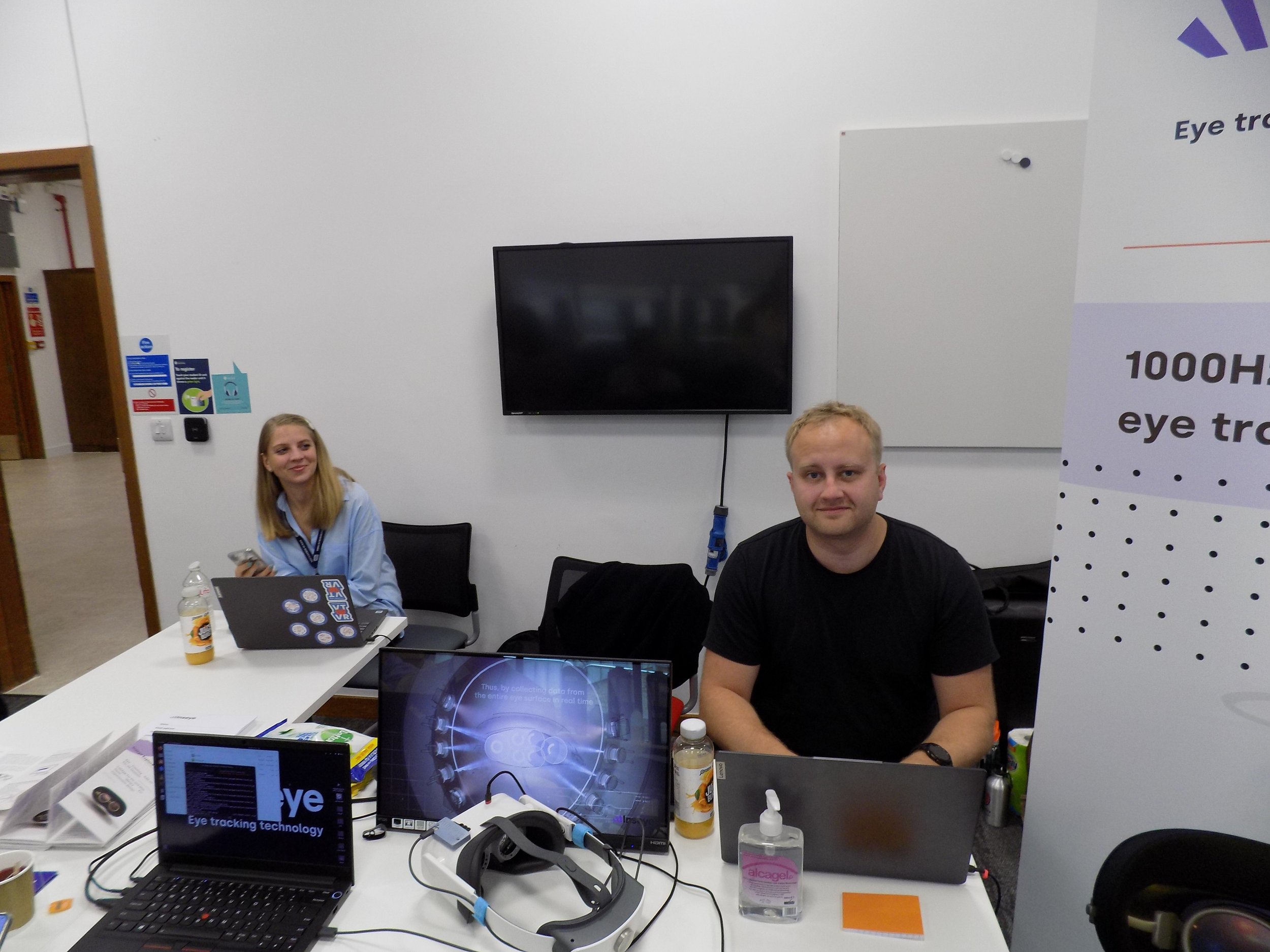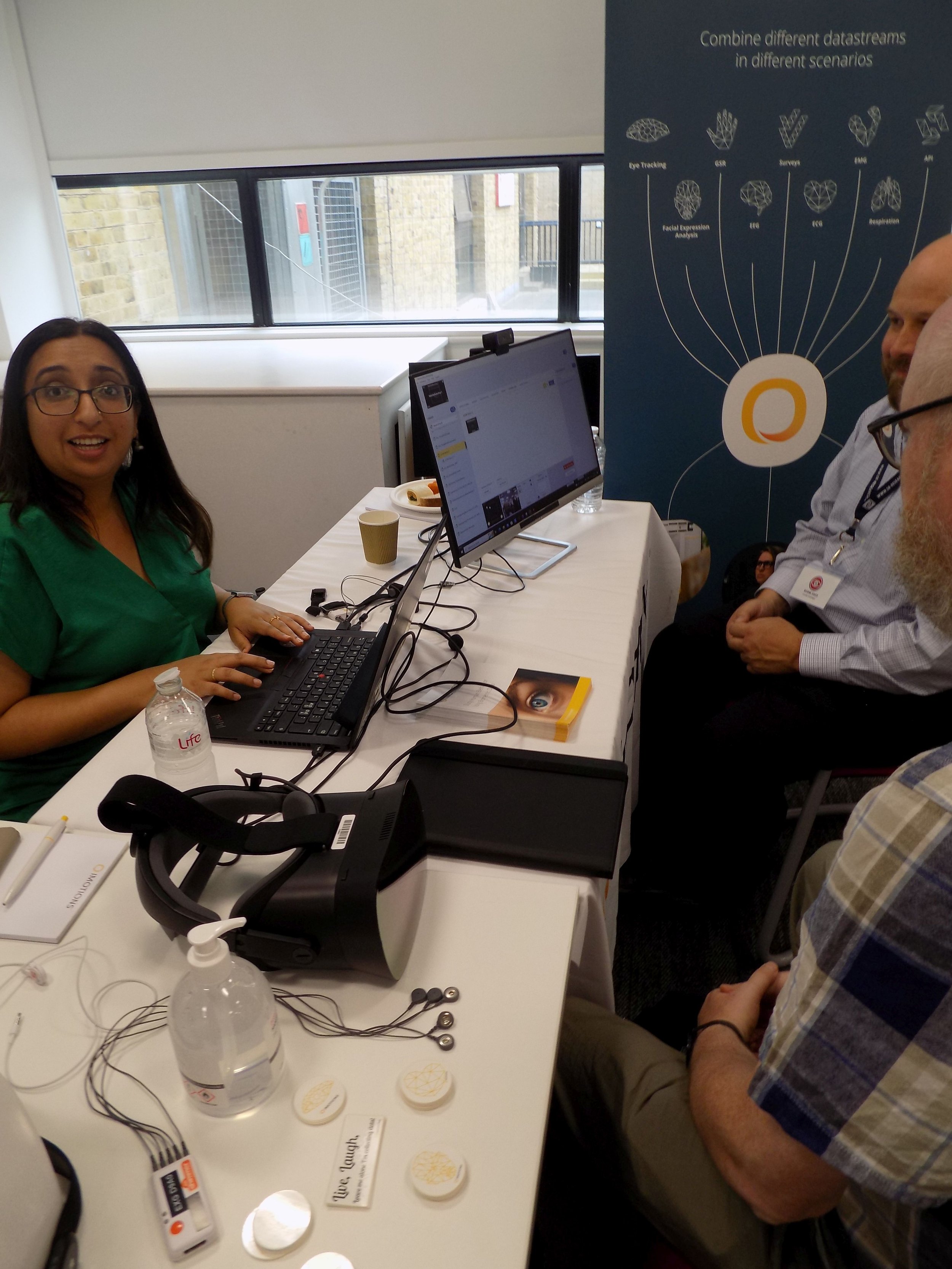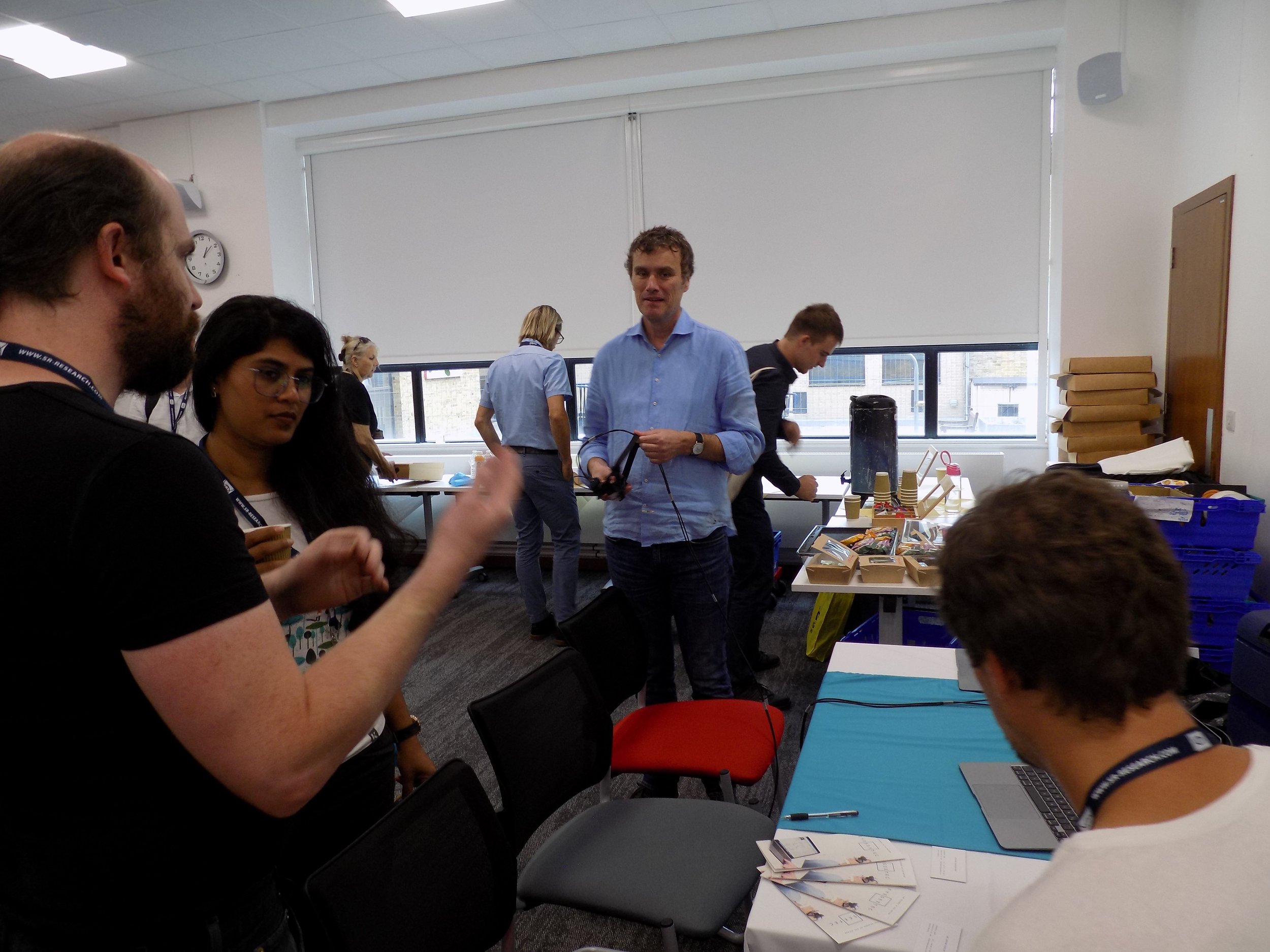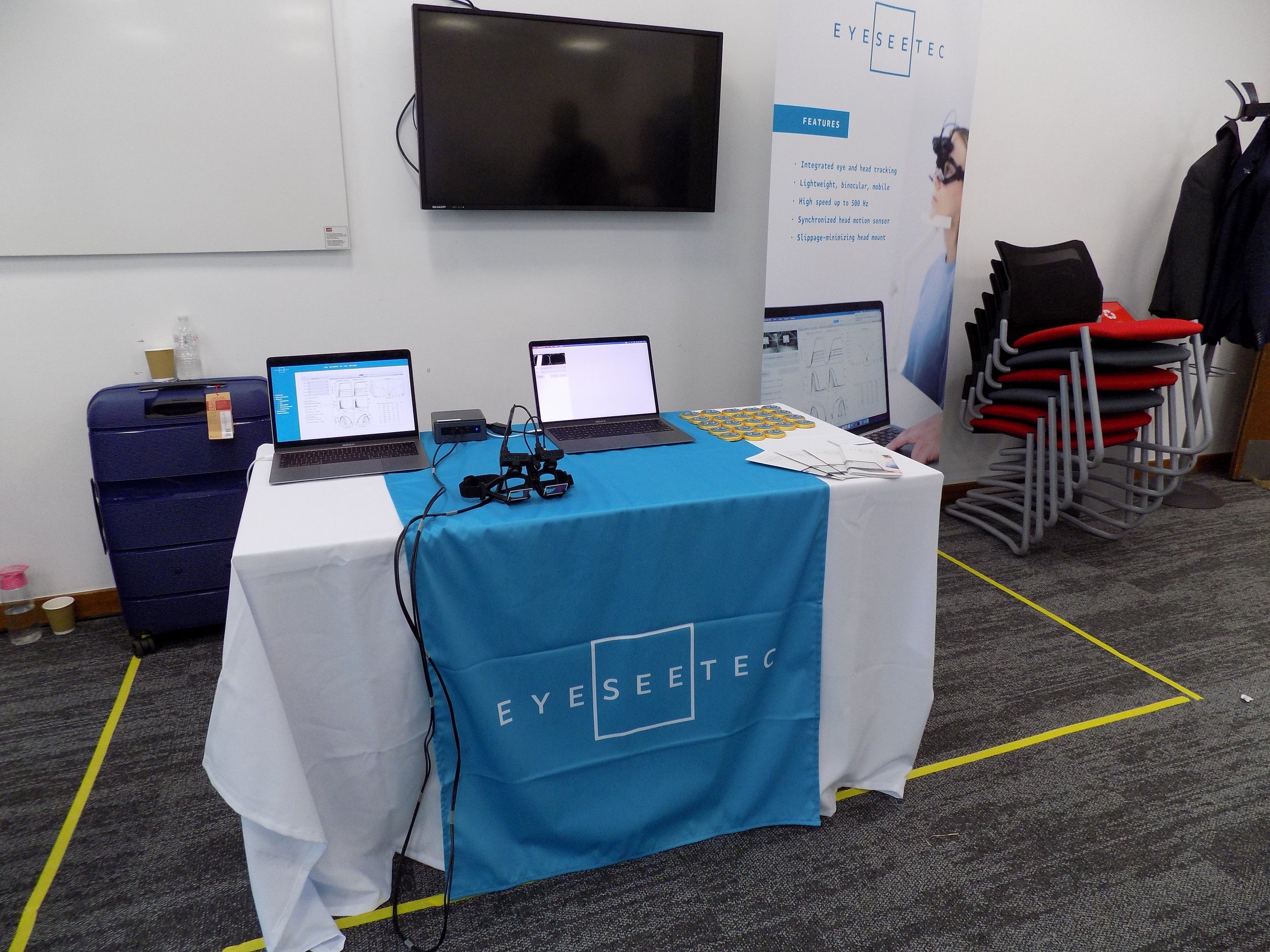-
BENNETT LECTURE THEATRE 8 - 10:40- 11:00
This Vortex Cannot be Pursued
Krischan Koerfer, Tamara Watson and Markus Lappe
University of Muenster, Germany
krischan.koerfer@uni-muenster.de
Non-rigid motion of water, clouds, smoke, fire etc. is omnipresent in our world and its visual perception is intermingled with eye movements. Here, we investigated the pursuit of non-rigid motion by presenting a vortex motion pattern in a random dot distribution. The vortex moved across the screen, independent of the first-order motion within it. We asked 15 participants to pursue this vortex. We found pursuit gain was almost zero and the frequent catch-up saccades were too short, landing where the vortex had been during saccade planning. Furthermore, participants reported that the vortex appeared to jump during pursuit. In contrast, the vortex was perceived as moving smoothly when, at each saccade landing, it jumped backwards to the position where it had been during saccade planning. In a control fixation task, participants perceived the motion as smooth, without jumps. We conclude that the pursuit system cannot incorporate the movement of motion patterns, despite our earlier reported findings that participants can accurately perceive such motion. Additionally, a subsequent direction discrimination task with varying stimulus duration showed that non-rigid motion processing takes longer than rigid motion processing. We propose a separate non-rigid motion processing pathway that does not feed into the pursuit system.
-
EYE MOVEMENT CONTROL IN READING III
BENNETT LECTURE THEATRE 2 - 15:30- 15:50
Reader Targeting of Words is Guided by the Distribution of Information in the Lexicon
Jon Carr and Davide Crepaldi
SISSA, Italy
jcarr@sissa.it
Skilled readers typically identify words more accurately when fixating them slightly left of the central character, the so-called optimal viewing position. There are two main explanations for this effect, which are not mutually exclusive. The first claims that the optimal viewing position lies left-of-center due to the particular constraints of the human perceptual system. The second explains the effect in terms of how words compete with each other; specifically, the beginnings of words tend to be more unique and therefore more informative about word identity, making a left-of-center fixation more advantageous. We explore this effect through the lens of a Bayesian cognitive model and two experiments using artificial lexicons in which we can carefully control how information is distributed across wordforms. Our results suggest that readers are sensitive to the distribution of information, targeting different positions depending on whether the language they learned is more informative on the left or right. Furthermore, readers do not simply target the position that contains the most information; rather, they target the position that will yield the best view of the word overall, accounting for both information distribution and the asymmetry of the human visual span.
-
SYMPOSIUM: EYE MOVEMENTS IN MEMORY PROCESSES: BETWEEN WORKING MEMORY AND LONG-TERM MEMORY
BENNETT LECTURE THEATRE 1 - 10:20- 10:40
What the Variations in Saccade Metrics and Visual Memory Across the Visual Field Tell About Saccadic Selection in Visual Working Memory
Sven Ohl
Humboldt-Universität zu Berlin, Germany sven.ohl@hu-berlin.de
Saccades select content that is currently maintained in visual working memory—resulting in better memory at locations that are congruent with the saccade target than at incongruent locations. Using a data set of nine experiments (including eight published experiments) with more than 100k trials, we further substantiate the claim of a fundamental saccadic selection mechanism in memory by assessing whether saccadic selection is effective in all participants and at all tested locations. In the experiments, we briefly presented arrays of oriented stimuli at eight possible locations that were arranged on an imaginary circle around central fixation. Several hundred milliseconds later, a movement cue prompted saccades to one of these locations. Next, participants were prompted to report the orientation (clockwise vs. counterclockwise) of the memory item at a randomly highlighted location. Using Bayesian hierarchical models, we observed saccadic selection in memory at all tested locations. Individual differences in saccadic selection were compatible with a population-wide model of effective saccadic selection. Moreover, saccade metrics and visual working memory varied strongly across the visual field. Trial-by-trial variations in saccade metrics were associated with memory performance, providing additional evidence for a bi-directional link between the oculomotor system and visual working memory.
-
READING DEVELOPMENT
BENNETT LECTURE THEATRE 2 - 13:00- 13:20
Seven Years Later – Executive Functioning Predicts the Development of the Perceptual Span during Reading
Johannes M Meixner and Jochen Laubrock
Brandenburg Medical School Theodor Fontane (MHB), Germany
johannes.meixner@mhb-fontane.de
The perceptual span indicates how much visual information can be processed within a single fixation. Here, we present data from two new waves of our longitudinal developmental study of the perceptual span during reading with more than 100 primary-school students, extending the data-collection period from first grade up to middle school. Overall, the size of the perceptual span did not significantly increase but rather stabilized during middle school – remaining at the level of sixth-graders. Matthew effects we reported earlier for early reading development resulted in stable and pronounced inter-individual differences at later grades for the high-level measures reading rate and perceptual span, whereas low-level oculomotor measures such as fixation duration and saccade length revealed compensatory patterns. Measures of executive functioning predicted reading performance seven years later: Children, who initially performed above average in both early reading and executive functioning, finally developed a much larger perceptual span and a higher reading rate compared to their initially below-average performing peers. This suggests that (in combination with linguistic skills) the efficient operation of executive functions such as shifting of attention, updating of working memory, and inhibition of pre-potent responses qualifies as a determinant of the development of the perceptual span.
-
POSTER SESSION II, 2 ATTENTION
STUDENT UNION SQUARE HALL - 15:00- 16:30
Attentional Biases in the Size of Fixational Saccades
Baiwei Liu, Anne Zonneveld and Freek van Ede
Vrije Universiteit Amsterdam, Netherlands
b.liu@vu.nl
It is well established that spatial attention can bias the direction of fixational saccades. It remains unknown whether and when attention may also bias the size (amplitude) of fixational saccades. To investigate this, we cued attention to one of multiple items in visual working memory while manipulating the spatial demands on attention. In one condition, trials contained two colored tilted bars (presented to the left and right) that were both either near or far from fixation. A color cue (presented during the delay) instructed participants to select either memorandum. Additionally, we included a load-four condition in which items occupied the near and far locations on both sides. Critically, in these trials, the direction is not sufficient to select the cued memorandum as there are always two memoranda in the same direction (one near, one far). Consistent with prior work, we confirm that the direction of fixational saccades was robustly biased by the memorized location of the attended memorandum. More importantly, our data reveal that the size of the directionally biased fixational saccades was also modulated by the spatial demands on attention. Specifically, fixational saccades became larger when selecting the far item, but only when direction was insufficient.
-
POSTER SESSION I, 24 READING
STUDENT UNION SQUARE HALL - 15:00- 16:30
The Processing of Chinese Three-character Idioms with a “1+2” Modifier-noun Structure
Ying Fu, Simon P. Liversedge, Xuejun Bai, Guoli Yan and Chuanli Zang
Tianjin Normal University, China
yfu11@uclan.ac.uk
Previous evidence demonstrates that Chinese three-character idioms with a 2-character modifier and 1-character noun structure (2+1 MN) are processed as Multi-Constituent Units (MCUs, Zang et al., 2021). However, it is unclear whether idioms with a 1-character modifier and 2-character noun structure (1+2 MN) are processed as MCUs, as there are less constraints from the first constituent over the second compared with 2+1 idioms. In Experiment 1, we monitored participants’ eye movements when they read sentences with embedded idioms. Idioms were either presented normally (without segmentation highlighting), or highlighted with segmentations for whole MCUs, or constituent parts that did or did not coincide with the structure. Reading times were shortest for whole unit segmentations and longer for non-structural segmentations. Experiment 2, used the boundary paradigm (Rayner, 1975) to orthogonally manipulate preview of the modifier and noun of 1+2 idioms (identity or pseudocharacter). A greater preview of the noun occurred on the modifier when the modifier was an identity than pseudocharacter preview. Overall, these results suggest that Chinese idioms with a 1+2 MN structure are processed as MCUs, both foveally and parafoveally.
-
POSTER SESSION I, 3 ATTENTION
STUDENT UNION SQUARE HALL - 15:00- 16:30
A Time-course Analysis of Food Cue Processing
Jonas Potthoff and Anne Schienle
University of Graz, Austria
jonas.potthoff@uni-graz.at
Background: Previous eye-tracking research has demonstrated that high-calorie food cues capture visual attention, particularly in individuals with overweight and weight concerns. The present experiment investigated whether this attentional bias can be influenced by context variables (i.e., the presence of pleasant low-calorie cues), and changes over time. This was studied via time-course analysis.
Method: Ninety women (mean age = 25 years) were presented with 60 picture pairs (à 6 s) that either showed a combination of high-calorie food + low-calorie food, high-calorie food + non-food, or low-calorie food + non-food. The women were assigned to one of three groups (n = 30): overweight with weight concerns (OW+), normal-weight with weight concerns (NW+), and normal weight without weight concerns (NW-). The relative number of fixations on (high-calorie) food cues was examined across the course of the picture pair presentations for one-second intervals.
Results: High-calorie food was fixated more often than low-calorie food and non-food only during the first second of the picture pair presentation. Subsequently, all participants (independent of the group assignment) showed the tendency to gaze at low-calorie cues when these cues were combined with high-calorie cues.
Conclusion: This study revealed timing-related context effects on visual food cue reactivity. While the early attentional bias to high-calorie cues could not be changed by context, this was possible during the later processing stage. Future studies need to examine whether the observed context effect can influence food choices and eating behavior.
adjudication committee
The selection committee for the awards was composed of Lynn Huestegge, Amelia Hunt, Jukka Hyönä, Ignace T. C. Hooge, Johanna K. Kaakinen, Eugene McSorley, Ralf Radach, Trevor Crawford and Françoise Vitu. The selection of the Keith Rayner Memorial Award was chaired by Simon Liversedge. The selection of the SR Research awards was chaired by David Souto.
The Keith Rayner Memorial Award
It is a pleasure to announce that there will be a Keith Rayner Memorial Award at the Leicester European Conference on Eye Movements 2022 in memory of Keith Rayner and his contribution to the field of eye movements and cognitive psychology. The prize will be awarded to the best student (poster or spoken) presentation at the conference as decided by the adjudication committee.
Keith Rayner was a very important figure in the field of eye movements and cognitive psychology. He made a substantial and significant scientific contribution, and he viewed ECEM as a very important conference. Keith was also an amazing mentor to so many young investigators. This award is about honouring both the contribution that Keith made, as well as Keith as a person, and it is hoped that in a small way this award can help continue his legacy. It is also hoped that the award will encourage participation by graduate students in future ECEM conferences.
If you are a student and you are presenting a poster or a paper at ECEM 2022 (i.e., you are the primary author on the presentation and you will deliver the presentation), then you are eligible for consideration for the award. The adjudication process for the award will be as follows: Any person wishing to be considered for the award will be required to send a concise abstract (100 words or less excluding the title), and a statement declaring that the presenter will be a student at the time of the presentation, to the following email address: ECEM2022@leicester.ac.uk.
The word limit for the concise abstracts will be strictly observed and any abstract longer than 100 words will not be considered. All abstracts must be submitted to this email address one week before the conference. Any abstracts submitted after this point will not be considered.
All the eligible abstracts will be evaluated by the adjudication committee comprised of well-respected colleagues who will attend the conference. On the basis of the abstracts, members of the adjudication committee will attend candidate presentations for the award, and after the conference a committee decision will be formulated and a winner announced (hopefully at the conference, but if schedule constraints prevent this, then via an announcement on the ECEM website). Thus, decisions will be made according to a two-stage process (shortlist on the basis of concise abstracts, followed by a final decision on the basis of the quality of the shortlisted presentations). The award will take the form of a monetary prize.
If you are eligible for the Keith Rayner Award, and you would like to be considered, I strongly encourage you to submit an abstract. If you have any questions regarding the award, or the decision process, please do not hesitate to contact me by email.
With best wishes
Simon P. Liversedge
SPLiversedge@uclan.ac.uk
Early Career Awards: Best talk and best poster contribution
Two early career (up to 10 years post PhD) awards (a cash prize) will be given for the best talk and for the best poster contribution, sponsored by SR-Research.
To be considered for those two awards send an email with the abstract for your contribution stating the award to which you would like to be considered to ECEM2022@leicester.ac.uk. You need to be the listed as first author of the contribution. The adjudication process will be similar to the Keith Rayner Memorial Award.



